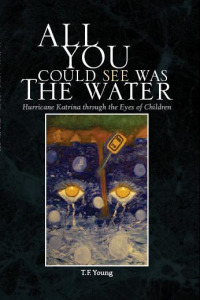Many Floridians have gone through this scenario: After hours of a hurricane’s wrath, the sun finally starts to peek through the clouds, the rain stops and all that’s left of a once-terrible storm are puddles and scattered debris on your driveway.
But picture this. Suddenly, two explosions shatter the peace followed by a huge tidal wave of water that heads down the street straight toward homes.
That is exactly what 13-year-old survivor Gabby experienced when the levies broke in New Orleans more than three years ago. Her story is preserved in the book “All You Could See Was the Water: Hurricane Katrina through the Eyes of Children,” written by UNF senior literature major Thelma Young and published Aug. 29 on the storm’s three-year anniversary.
“I want to give a voice to people who wouldn’t otherwise have one, and I feel like children a lot of times aren’t listened to,” Young said. “I thought it would be interesting to get a feel of what Katrina was like through their eyes.”
 As an oral history transcriber at UNF’s Thomas G. Carpenter Library, Young said she believes recording the life stories of others is the key to capturing our generation for future ages to remember and understand.
As an oral history transcriber at UNF’s Thomas G. Carpenter Library, Young said she believes recording the life stories of others is the key to capturing our generation for future ages to remember and understand.
The Dean’s Leadership Council funded her belief in 2005 with a Transformational Learning Grant valued at close to $1,000. Young spent two years from 2006 to 2008 doing research for the book.
Her book tells the stories of 11 children who lived through Hurricane Katrina to tell of its destruction. Her interest in these stories ties into her own family who lives in her hometown of Biloxi, Miss., and in New Orleans.
“I can remember the Sunday before Katrina calling my brothers and my mom [in Biloxi] and pleading with them to evacuate,” Young said. “Monday morning rolled around and I got a phone call that 10 of my family members were already in the attic and that the water was already inside the attic.”
After two days of no communication, she assumed no one had survived, but all 10 people were able to escape after 10 hours of entrapment, she said.
“That was just a personal goal of mine to make some sort of statement of remembrance because I think a lot of people have forgotten that people are still struggling to put their lives back together,” Young said. “I still have a cousin in New Orleans who’s actually living in a FEMA trailer in her front yard to this day waiting for her house to be repaired.”
Rather than stay, some of the children in the book moved away from their hometowns to start new lives after the storm demolished everything.
As children, many had little choice in the matter, Young said.
“All the children wanted to [evacuate], but they were powerless because they were so young,” Young said.
When people ask Young what message they will take from the book, she tells them, “you should never try to face a hurricane without plan A and B,” she said.
Transcribing the stories of the families who didn’t have such plans in the wake of Katrina was “overwhelmingly sad,” but she tried to end each chapter on an upbeat note, Young said.
“They all feel like even though they went through hell, they’re fortunate to have survived it, and they plan on making the best of the life that they have left,” she said.
E-mail Rebecca McKinnon at staff3@unfspinnaker.com.











